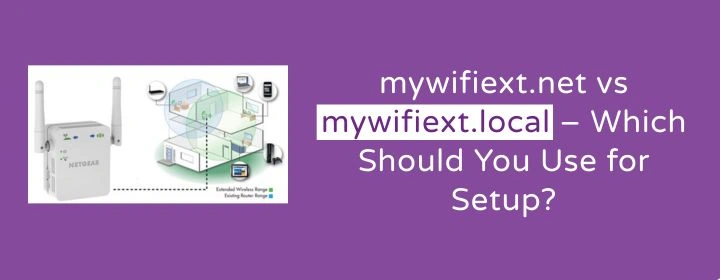One of the first things you need to do when setting up a Netgear WiFi extender is go to its setup site. This is when things usually become confusing. Mywifiext.local or mywifiext.net? Both are right, yet they signify different things. Knowing which one works with your device can save you time and prevent common extension setup problems.
Why two different addresses exist in the first place
This is where most of the head scratching starts. What is the use of two addresses when one works the same way:
Here’s the thing:
- mywifiext.net is the default web address that works on Windows PCs or most devices that are directly connected to the extender.
- mywifiext.local is more for Mac or iOS users, since Apple devices sometimes don’t like resolving the .net page.
Therefore, they’re both basically shortcuts that point you to the extender’s login page. Netgear just decided to keep both open so no one gets stuck, regardless of what type of computer or phone they’re using.
That’s it. Nothing mystical about it.
What is the use of these addresses?
When you open mywifiext.net in your browser, the request isn’t going out to the internet. It’s being caught by your extender itself. Think of it like a backstage door into the device’s brain. Same with mywifiext.local. The extender grabs the request, opens up the login panel, and lets you configure things.
So, if either one doesn’t load, the issue isn’t with the internet or Netgear’s servers. It’s usually just your device not properly connecting to the extender at that moment.
The first-time setup – which should you pick?
Let’s say you’ve just plugged in your new extender. Lights are on, it’s powered up. Here’s what you do:
- Connect your laptop or phone to the extender’s default WiFi name (something like Netgear_EXT).
- Open a browser.
- Try mywifiext.net first if you’re on a Windows PC or Android.
- If that doesn’t load, especially on a MacBook or iPhone, try mywifiext.local instead.
Either way, you’ll land at the same place: the extender login page. From there you’ll create an admin password, link the extender to your main WiFi, and you’re good.
When things go wrong
Of course, it doesn’t always go this smooth. A few bumps you might hit:
- Page not loading: Nine out of ten times, this is because your device isn’t connected to the extender’s WiFi. Double-check that first.
- Spelling mistakes: It’s not “mywifi.com” or “wifi.ext”. It’s literally mywifiext.net or mywifiext.local. Even small typos won’t work.
- Cache problems: If you’ve tried a bunch of times, your browser may get stuck. Clear the cache or open in Incognito.
- Wrong network: If you’re still on your router’s WiFi while typing the URL, you’ll just get a blank page. Make sure you’ve switched.
Advanced note: IP address method
Some people skip the whole .net vs. local debate and just go directly through the extender’s IP address, which is usually 192.168.1.250. If you type that in, you’ll land at the same login page. This method always works, but most folks prefer the easy-to-remember addresses.
Everyday use after setup
Here’s the good news: once you’ve set up your extender, you probably won’t need to mess with these URLs very often. You’ll connect to your boosted WiFi network like normal, and the extender does the heavy lifting quietly in the background.
Still, if you ever want to:
- Change the WiFi name or password.
- Update the extender’s firmware.
- Reset the settings.
You’ll go back to the same login page through mywifiext.net or mywifiext.local.
The big difference summarized
Let’s boil it down into one line:
- mywifiext.net: Best for Windows and most standard devices.
- mywifiext.local: Best for Mac/iOS when the .net page won’t load.
That’s really all there is to it.
Common mistakes people make
I’ve seen a lot of users get frustrated with really simple issues, so let’s list them out:
- Trying to open the URL without connecting to the extender first. That’ll never work.
- Assuming it’s an internet website. It’s not. It’s local. If your extender’s off, the page won’t load.
- Mixing up passwords. Your router’s WiFi password is different from the extender’s admin password. Write them down.
- Ignoring firmware updates. Extenders do get better with updates, and sometimes they fix connection bugs.
Resetting if you’re stuck
If nothing works—like really nothing—the easiest way back is a reset.
- Find the reset button at the back or side of the extender.
- Hold it in with a pin for 10 seconds.
- Lights will blink and it’ll restore to factory state.
- Then reconnect to Netgear_EXT and try again with either mywifiext.net or mywifiext.local.
Resets solve more problems than people realize.
Wrap-up
So, which should you use—mywifiext.net or mywifiext.local? Honestly, it depends on your device. They both lead to the same place, so it’s not really a competition. Try .net first, and if it doesn’t load, go with. local. Simple as that.
Once you’re past that, the extender does its thing quietly.


